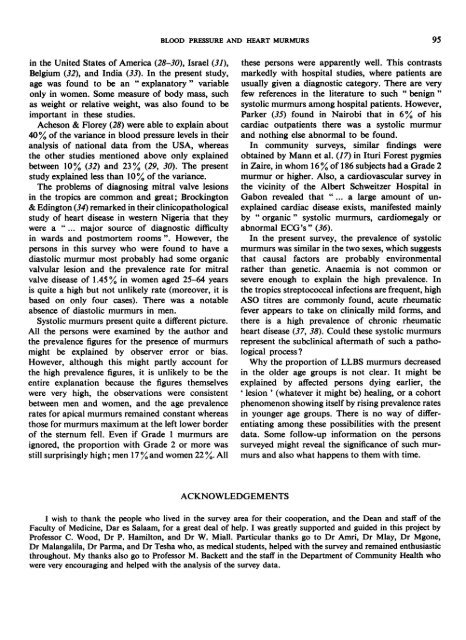Blood pressure and heart murmurs in a rural population in the ...
Blood pressure and heart murmurs in a rural population in the ...
Blood pressure and heart murmurs in a rural population in the ...
Create successful ePaper yourself
Turn your PDF publications into a flip-book with our unique Google optimized e-Paper software.
BLOOD PRESSURE AND HEART MURMURS95<strong>in</strong> <strong>the</strong> United States of America (28-30), Israel (31),Belgium (32), <strong>and</strong> India (33). In <strong>the</strong> present study,age was found to be an " explanatory " variableonly <strong>in</strong> women. Some measure of body mass, suchas weight or relative weight, was also found to beimportant <strong>in</strong> <strong>the</strong>se studies.Acheson & Florey (28) were able to expla<strong>in</strong> about40% of <strong>the</strong> variance <strong>in</strong> blood <strong>pressure</strong> levels <strong>in</strong> <strong>the</strong>iranalysis of national data from <strong>the</strong> USA, whereas<strong>the</strong> o<strong>the</strong>r studies mentioned above only expla<strong>in</strong>edbetween 10% (32) <strong>and</strong> 23% (29, 30). The presentstudy expla<strong>in</strong>ed less than 10% of <strong>the</strong> variance.The problems of diagnos<strong>in</strong>g mitral valve lesions<strong>in</strong> <strong>the</strong> tropics are common <strong>and</strong> great; Brock<strong>in</strong>gton& Ed<strong>in</strong>gton (34) remarked <strong>in</strong> <strong>the</strong>ir cl<strong>in</strong>icopathologicalstudy of <strong>heart</strong> disease <strong>in</strong> western Nigeria that <strong>the</strong>ywere a "... major source of diagnostic difficulty<strong>in</strong> wards <strong>and</strong> postmortem rooms ". However, <strong>the</strong>persons <strong>in</strong> this survey who were found to have adiastolic murmur most probably had some organicvalvular lesion <strong>and</strong> <strong>the</strong> prevalence rate for mitralvalve disease of 1.45% <strong>in</strong> women aged 25-64 yearsis quite a high but not unlikely rate (moreover, it isbased on only four cases). There was a notableabsence of diastolic <strong>murmurs</strong> <strong>in</strong> men.Systolic <strong>murmurs</strong> present quite a different picture.All <strong>the</strong> persons were exam<strong>in</strong>ed by <strong>the</strong> author <strong>and</strong><strong>the</strong> prevalence figures for <strong>the</strong> presence of <strong>murmurs</strong>might be expla<strong>in</strong>ed by observer error or bias.However, although this might partly account for<strong>the</strong> high prevalence figures, it is unlikely to be <strong>the</strong>entire explanation because <strong>the</strong> figures <strong>the</strong>mselveswere very high, <strong>the</strong> observations were consistentbetween men <strong>and</strong> women, <strong>and</strong> <strong>the</strong> age prevalencerates for apical <strong>murmurs</strong> rema<strong>in</strong>ed constant whereasthose for <strong>murmurs</strong> maximum at <strong>the</strong> left lower borderof <strong>the</strong> sternum fell. Even if Grade 1 <strong>murmurs</strong> areignored, <strong>the</strong> proportion with Grade 2 or more wasstill surpris<strong>in</strong>gly high; men 17 % <strong>and</strong> women 22 %. All<strong>the</strong>se persons were apparently well. This contrastsmarkedly with hospital studies, where patients areusually given a diagnostic category. There are veryfew references <strong>in</strong> <strong>the</strong> literature to such " benign "systolic <strong>murmurs</strong> among hospital patients. However,Parker (35) found <strong>in</strong> Nairobi that <strong>in</strong> 6% of hiscardiac outpatients <strong>the</strong>re was a systolic murmur<strong>and</strong> noth<strong>in</strong>g else abnormal to be found.In community surveys, similar f<strong>in</strong>d<strong>in</strong>gs wereobta<strong>in</strong>ed by Mann et al. (17) <strong>in</strong> Ituri Forest pygmies<strong>in</strong> Zaire, <strong>in</strong> whom 16% of 186 subjects had a Grade 2murmur or higher. Also, a cardiovascular survey <strong>in</strong><strong>the</strong> vic<strong>in</strong>ity of <strong>the</strong> Albert Schweitzer Hospital <strong>in</strong>Gabon revealed that "... a large amount of unexpla<strong>in</strong>edcardiac disease exists, manifested ma<strong>in</strong>lyby " organic" systolic <strong>murmurs</strong>, cardiomegaly orabnormal ECG's" (36).In <strong>the</strong> present survey, <strong>the</strong> prevalence of systolic<strong>murmurs</strong> was similar <strong>in</strong> <strong>the</strong> two sexes, which suggeststhat causal factors are probably environmentalra<strong>the</strong>r than genetic. Anaemia is not common orsevere enough to expla<strong>in</strong> <strong>the</strong> high prevalence. In<strong>the</strong> tropics streptococcal <strong>in</strong>fections are frequent, highASO titres are commonly found, acute rheumaticfever appears to take on cl<strong>in</strong>ically mild forms, <strong>and</strong><strong>the</strong>re is a high prevalence of chronic rheumatic<strong>heart</strong> disease (37, 38). Could <strong>the</strong>se systolic <strong>murmurs</strong>represent <strong>the</strong> subcl<strong>in</strong>ical aftermath of such a pathologicalprocess?Why <strong>the</strong> proportion of LLBS <strong>murmurs</strong> decreased<strong>in</strong> <strong>the</strong> older age groups is not clear. It might beexpla<strong>in</strong>ed by affected persons dy<strong>in</strong>g earlier, <strong>the</strong>'lesion ' (whatever it might be) heal<strong>in</strong>g, or a cohortphenomenon show<strong>in</strong>g itself by ris<strong>in</strong>g prevalence rates<strong>in</strong> younger age groups. There is no way of differentiat<strong>in</strong>gamong <strong>the</strong>se possibilities with <strong>the</strong> presentdata. Some follow-up <strong>in</strong>formation on <strong>the</strong> personssurveyed might reveal <strong>the</strong> significance of such <strong>murmurs</strong><strong>and</strong> also what happens to <strong>the</strong>m with time.ACKNOWLEDGEMENTS1 wish to thank <strong>the</strong> people who lived <strong>in</strong> <strong>the</strong> survey area for <strong>the</strong>ir cooperation, <strong>and</strong> <strong>the</strong> Dean <strong>and</strong> staff of <strong>the</strong>Faculty of Medic<strong>in</strong>e, Dar es Salaam, for a great deal of help. I was greatly supported <strong>and</strong> guided <strong>in</strong> this project byProfessor C. Wood, Dr P. Hamilton, <strong>and</strong> Dr W. Miall. Particular thanks go to Dr Amri, Dr Mlay, Dr Mgone,Dr Malangalila, Dr Parma, <strong>and</strong> Dr Tesha who, as medical students, helped with <strong>the</strong> survey <strong>and</strong> rema<strong>in</strong>ed enthusiasticthroughout. My thanks also go to Professor M. Backett <strong>and</strong> <strong>the</strong> staff <strong>in</strong> <strong>the</strong> Department of Community Health whowere very encourag<strong>in</strong>g <strong>and</strong> helped with <strong>the</strong> analysis of <strong>the</strong> survey data.
















